As the current battle against the coronavirus rages and images of wartime are invoked, memories of the famous “victory gardens” of World War I and II come to mind. During both wars, over 20 million victory gardens, large and small, were planted and produced almost 40 percent of the nation’s fresh vegetables. People grew their own produce in planters, on fire escapes, in empty lots and backyards.
Today, as the pandemic takes hold around the world, panicky shoppers are cleaning out stores, and basic foods like dried beans and potatoes are becoming increasingly difficult to find. As a result, even individuals with no gardening experience are searching YouTube for DIY videos on building raised beds and planting gardens.
Growing your own food can be as simple as having a few pots or planters out on your deck to as complex as turning a large section of your landscape into a highly productive produce resource. It’s not as difficult as you might think and the benefits are myriad.
The incentive to grow your own is even greater than simply feeding your family better – you’ll be joining a growing food revolution that is gathering speed in response to the damage being done to the planet by industrial agriculture.
> See our Home Vegetable Garden Portfolio <
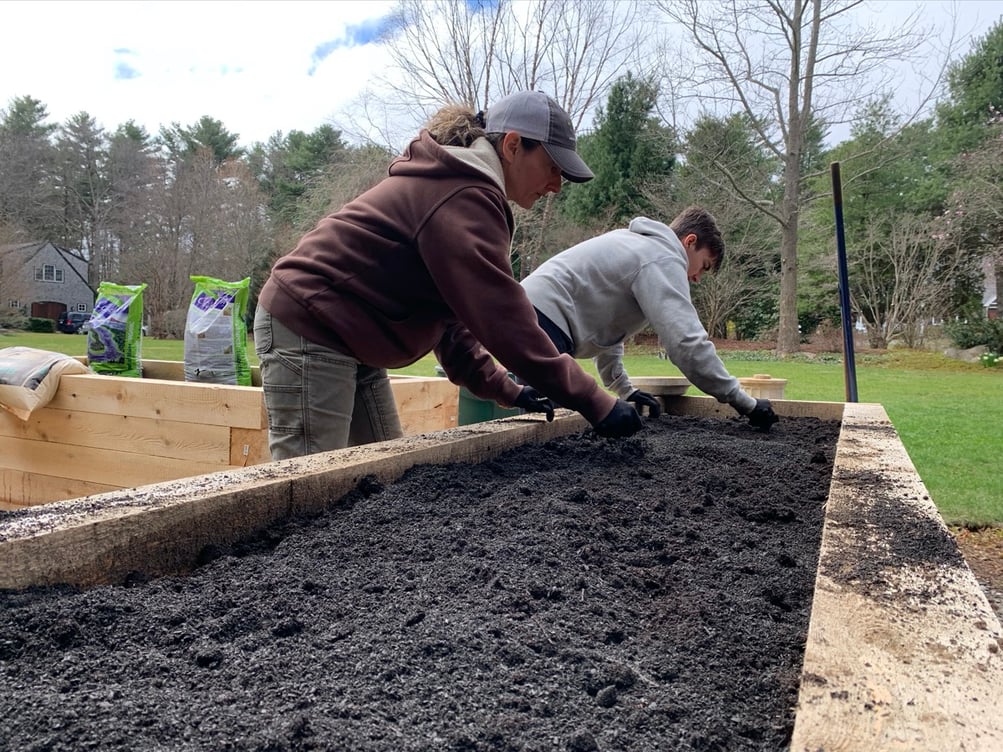 My son, Bennett, is helping me to amend our raised vegetable boxes with Coast of Maine's Quoddy Blend Compost and organic Biochar.
My son, Bennett, is helping me to amend our raised vegetable boxes with Coast of Maine's Quoddy Blend Compost and organic Biochar.
Five great reasons for growing your own produce include:
- It’s more nutritious A diet with a variety of fresh fruits and vegetables is more diverse and healthy, packed with vitamins, minerals, and antioxidants to protect your cells. Foods with the shortest time between harvesting and eating retain the most nutritional value.
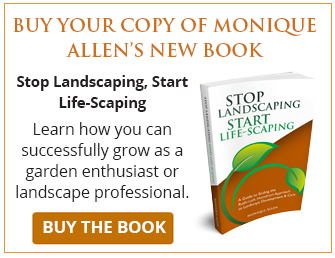 It helps you obtain vitamin D, not from the produce itself, but from the sunshine to which you’re exposed when you spend some time outdoors gardening. Vitamin D protects against certain diseases and helps you maintain healthy bones and teeth.
It helps you obtain vitamin D, not from the produce itself, but from the sunshine to which you’re exposed when you spend some time outdoors gardening. Vitamin D protects against certain diseases and helps you maintain healthy bones and teeth.- It provides healthy activity The physical activity required in gardening can improve cardiac health and immune system response; decrease heart rate and stress; and increase motor skills, flexibility, and body strength. Getting regular exercise helps relieve stress, anxiety, and depression while boosting energy.
- It saves you money Spending a little on seeds, plant starts, and gardening supplies can save you a lot at the supermarket.
- It’s better for the environment Even organic produce purchased at the supermarket often needs to be transported some distance, burning fossil fuel and contributing to climate change. Growing your own produce also enables you to better control and limit the use of chemical fertilizers, herbicides, and pesticides.
Now, you may be tempted to say “Why go to all the trouble of trying to grow my own when supermarkets already have plenty of fruits and vegetables?” And, yes, while many supermarkets are normally filled with fresh, colorful produce that seems to scream “healthy,” all might not be as nutritious as it seems.

TWEETABLE TIP
Growing your own food can be as simple as having a few pots or planters out on your deck to as complex as turning a large section of your landscape into a highly productive produce resource.
VIA @GardenContinuum

A study done by the University of Texas revealed that much of the produce grown today lacks the vitamins and minerals it once had several decades ago. Modern agricultural methods have stripped many nutrients from the soil and food value has been reduced in favor of faster-growing, more pest-resistant versions of popular fruits and vegetables. Even produce that contains higher levels of nutrients when it's first harvested will experience a depletion of that nutritional value over time as it travels hundreds or even thousands of miles across the country or across the globe to your supermarket and eventually your table.
An easy solution is to join a local community-supported agriculture (CSA) group or shop at a local farmer’s market to gain access to locally-grown, more nutritious produce. Another solution that will require a little more sweat equity is to build your own backyard vegetable garden and grow your own.
While starting your own garden is a great idea, it’s important to realize that it shouldn’t be solely as a response to all the current doom-and-gloom. Instead, a little shift in perspective is warranted. The idea of growing your own food should not be simply a strategy for combating hoarding, but seen as a way to embrace a more positive, healthy lifestyle the whole family can enjoy, now and in the future.
Your own little “victory garden” can be a source not just of food, but a place to grow plants with herbal and medicinal value as well. You can even take it a step further by combining history, beauty, and value into what’s called a potager, or French kitchen garden. These intimate and often intricate gardens have been popular since medieval times and intermingle vegetables, fruits, flowers, and herbs in a garden design that invites harvesting and consuming in a relaxing space that makes it easy to go from “farm to table.”
The secret to home gardening: don’t bite off more than you can chew
If you’re a first-time gardener, start off with one box or just a planter or two and get used to working in the garden regularly. Don’t build a large space unless you can tend it frequently.
Here are some tips that will help you start a successful home vegetable garden:
- Location, location location Pick a spot to locate your garden that provides plenty of sun, access to water, and protection from harsh weather. If you’re planting in the ground, make sure you have a healthy, viable, mineral-rich soil that will support good plant growth. Of course, if you’re using planters or raised box beds, you have the flexibility to locate them more conveniently because you’ll be supplying the growing medium. Just be sure to locate them as close to you as possible for easier access that encourages daily visits to water and maintain them.
- Build beds before the growing season If you’re building raised beds, be sure to get on it in April so you’re not wasting valuable time locating materials and doing construction when you should be growing. To ensure that you’re ready to plant at the right time, get an early start on planning, ordering materials, site-prepping, and building your beds so you’re ready to go in late spring. If you’re a procrastinator, another option is to build your beds at the end of the season and take advantage of your timing to, say, plant garlic that will be ready in the spring.
- Know when to grow It’s important to determine if your garden will begin with seeds you’ll need to sprout or whether you’ll be using seedlings, known as “starts,” that are started by a nursery and ready to plant when you purchase them. If you’re starting from seed, you’ll want to get going in March or April so they’ll be ready to put in the ground in May. If you are using “starts” purchased from a nursery then you should have located a good source and be ready to shop for them in May.

TWEETABLE TIP
The idea of growing your own food should not be simply a strategy for combating hoarding, but seen as a way to embrace a more positive, healthy lifestyle the whole family can enjoy, now and in the future.
VIA @GardenContinuum

Fortunately, there are lots of great resources out there to help the first-time home gardener get started – no need to reinvent the wheel. Whether you’re starting with a couple of planters that will fit easily on your deck, patio, or balcony, or going a bit bigger and thinking about building raised beds, there are places such as Gardener’s Supply Company and Alegria Farms that offer helpful advice and instructions as well as all the materials and kits you’ll need to begin producing your own fresh, nutritious produce.
Embracing home gardening to supplement your family’s food resources is as much a lifestyle choice as it is a dietary one. It can even be a viable way to help your community and the planet. Sources such as Alegria Farms help people not only maximize their health and fitness but reduce the environmental impact of industrial agriculture by supporting home gardeners in their efforts to produce their own, low-impact, high-value foods.
Whatever your choice, we here at The Garden Continuum are dedicated to supporting you in your efforts to create a better, more productive landscape. Here’s to you and your family enjoying happy gardening and healthy eating!

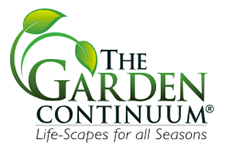
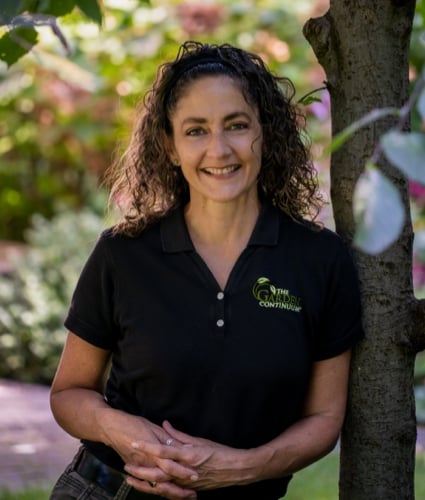
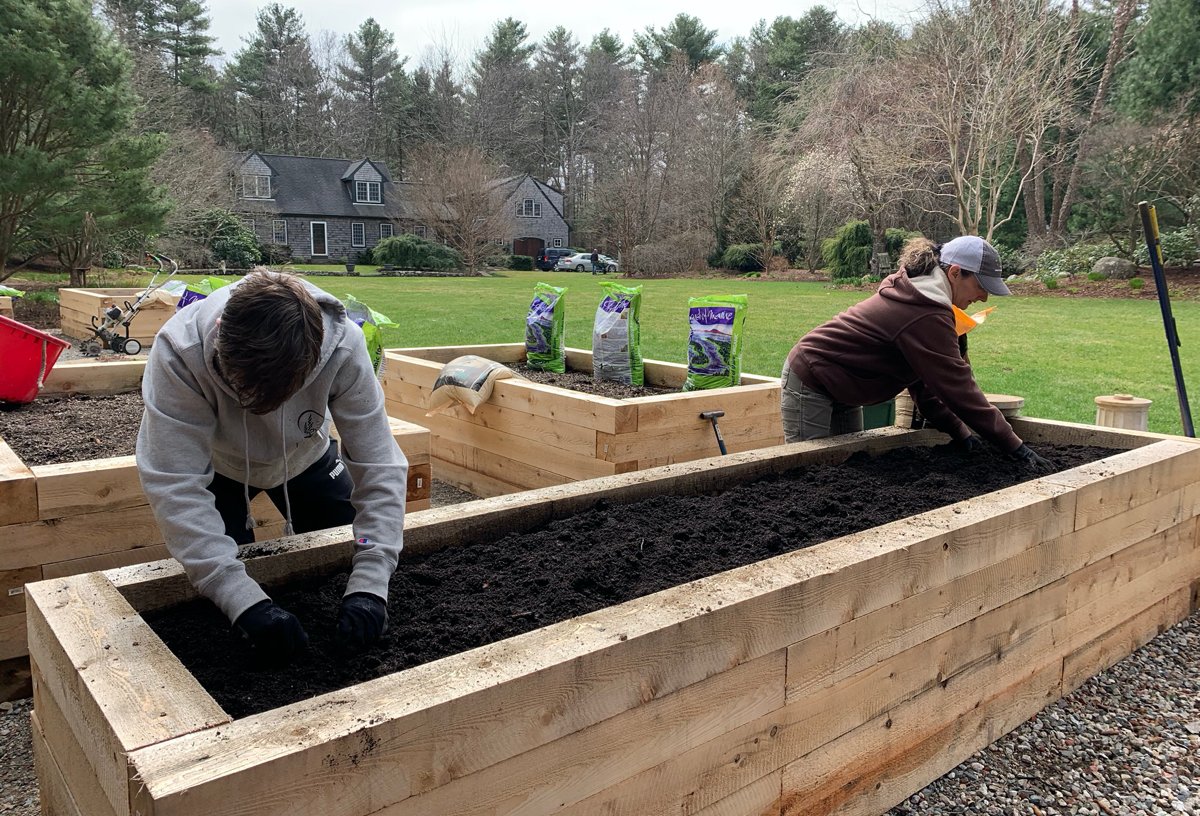
 My son, Bennett, is helping me to amend our raised vegetable boxes with Coast of Maine's Quoddy Blend Compost and organic Biochar.
My son, Bennett, is helping me to amend our raised vegetable boxes with Coast of Maine's Quoddy Blend Compost and organic Biochar.



Leave a comment